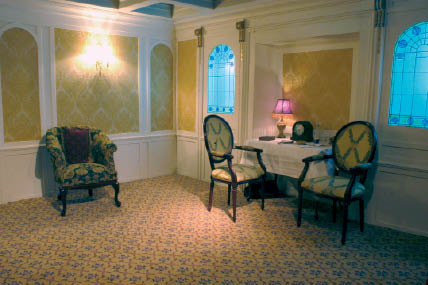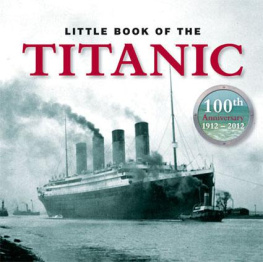Todd - The Little Book of Titanic: 100th Anniversary 1912-2012
Here you can read online Todd - The Little Book of Titanic: 100th Anniversary 1912-2012 full text of the book (entire story) in english for free. Download pdf and epub, get meaning, cover and reviews about this ebook. publisher: G2 Rights Ltd, genre: Science fiction. Description of the work, (preface) as well as reviews are available. Best literature library LitArk.com created for fans of good reading and offers a wide selection of genres:
Romance novel
Science fiction
Adventure
Detective
Science
History
Home and family
Prose
Art
Politics
Computer
Non-fiction
Religion
Business
Children
Humor
Choose a favorite category and find really read worthwhile books. Enjoy immersion in the world of imagination, feel the emotions of the characters or learn something new for yourself, make an fascinating discovery.
- Book:The Little Book of Titanic: 100th Anniversary 1912-2012
- Author:
- Publisher:G2 Rights Ltd
- Genre:
- Rating:5 / 5
- Favourites:Add to favourites
- Your mark:
- 100
- 1
- 2
- 3
- 4
- 5
The Little Book of Titanic: 100th Anniversary 1912-2012: summary, description and annotation
We offer to read an annotation, description, summary or preface (depends on what the author of the book "The Little Book of Titanic: 100th Anniversary 1912-2012" wrote himself). If you haven't found the necessary information about the book — write in the comments, we will try to find it.
This 100th anniversary book charts her fateful journey and describes the legends surrounding the sinking and the discovery of the wreck, and much more.
The Little Book of Titanic: 100th Anniversary 1912-2012 — read online for free the complete book (whole text) full work
Below is the text of the book, divided by pages. System saving the place of the last page read, allows you to conveniently read the book "The Little Book of Titanic: 100th Anniversary 1912-2012" online for free, without having to search again every time where you left off. Put a bookmark, and you can go to the page where you finished reading at any time.
Font size:
Interval:
Bookmark:
Competition between shipping lines was fierce during the last decade of the 19th century, and profits for the shipping companies involved were limited. In 1893 during a crossing of the Atlantic, the notable financier John Pierpont Morgan, who had interests in banking, railways and steel, was asked whether it was practical to try to buy up shipping lines in order to reduce competition and so encourage more realistic (and profitable) fares. Morgan thought that it ought to be, but it was not until later in the decade that he started to put this policy into practice when he acquired American Inman and Red Star lines.

*The Titanic under construction in the Arrol Gantry at the Harland & Wolff shipyard, Belfast.
In 1902 Morgan created the International Mercantile Marine Company (IMM) with the idea that competition on the all-important transatlantic route could be reduced through co-operation and thus profitability enhanced; IMMs route to co-operation was to buy up competitors.
Morgan bought into a number of shipping lines, including Atlantic Transport, Leyland and Dominion, before turning his attention to the larger British-owned companies, Cunard and White Star. After a bitter battle Morgan acquired White Star Line for 10 million, making former White Star Line managing director J Bruce Ismay chairman and managing director of IMM in early 1904. However, the Cunard deal was thwarted by the British government offering Cunard a soft loan that allowed the line to construct the Lusitania and Mauretania, and also providing 150,000 per annum as part of the mail contract. The scene was set for the development and construction of the Olympic class of liner in order to compete with the new ships under construction for Cunard.

*The Titanic in dry dock, February 1912.
Cunards new liners, both entering service in 1906, had been built for speed in an effort to claim the Blue Riband title for the fastest crossing of the North Atlantic, but there was a price to be paid for speed. Each additional knot required ever increasing amounts of coal and this added both to weight and cost. In looking towards Olympic and her sister vessels Titanic and Britannic, White Star Line decided against competing on speed but in favour of providing the greater luxury. Of the three, only the Olympic ever completed a commercial sailing, with Titanic being sunk on her maiden voyage and Britannic, converted for use as a hospital ship, being sunk in the Aegean Sea before she could enter commercial service following a mine strike during World War I.
Work was not yet complete on the Olympic when the keel of the Titanic was laid down in the Belfast shipyard of Harland & Wolff on 31 March 1909 as yard (ship) No 401 with hull No 390904. At 882ft 9in in length, the second in the Olympic class was six inches longer than the Olympic, but had an identical beam of 92ft 6in and a draught of 34ft 7in. The Titanic had a Gross Registered Tonnage (GRT) of 46,238 tons and a displacement of 52,310 tons.
She was fitted with two reciprocating four-cylinder, triple expansion steam engines to turn the two bronze triple-blade side propellers, and a single low-pressure Parsons turbine for the bronze four-blade central propeller. The engines that powered the three propellers were fed by 25 double-ended and four single-ended Scotch-type boilers, rated at 215psi, fired by 159 coal-burning furnaces. In all, the engines provided enough power to achieve a maximum speed of 23.75 knots with a service speed of 21 knots.
The ship was constructed with a double hull, designed to accommodate water for use in the boilers and additional water to provide ballast (hence stability) whilst at sea. The ship was, however, designed and built with only a single-skin hull.
Three of the ships four funnels were used to exhaust smoke and fumes from the engine room, whilst the fourth provided ventilation for the engine room and the air required to keep the fires in the furnaces alight. Thus, steam and smoke should only ever have been seen emerging from the leading three funnels; images that show smoke emerging from the fourth are incorrect.
Following the laying down of the keel, work proceeded rapidly on ship No 401, with the ship being launched shortly after noon on 31 May 1911 watched by an estimated crowd of some 100,000. On top of the gantry above the ship flew the Union Flag on one side and the Stars and Stripes on the other, with the White Star Lines red pennant flying in the middle. Below, a line of signal flags proclaimed the message SUCCESS.
With the Olympic now completed, the Harland & Wolff yard could turn its attention towards the final completion of the Titanic with a view to the ships maiden voyage beginning on 20 March 1912. However, two incidents to the Olympic the collision with HMS Hawke and the loss of a propeller required the ship to return twice to Belfast for repair. On the first return it became evident that the repair work required would cause serious delays to the completion of the Titanic and, on 10 October 1911, it was announced that the new ships maiden voyage would now begin on Wednesday 10 April 1912.

*The Titanic being guided down Belfast Lough by the tugs Hercules, Huskisson, Herculaneum and Hornby.
As the Titanic, along with her sister ships, had been designed for luxury and not primarily for speed, she was opulently fitted out to a standard that far exceeded that of any other liner then in service. She was provided with a squash court, separate libraries for all three classes of passenger, a Turkish bath, gymnasium and swimming pool. The first class rooms, in particular, were lavishly fitted out; the smoking room, for example, was provided with an old rose carpet and pink drapes over the curtains.

*The Titanic had many first class suites as seen in this replica.

*A replica of the first class hall on the Titanic.
However, the Titanic was unusual in that it offered reasonable facilities for third class passengers in an era when this class of passenger was generally poorly provided for. Apart from the third class library, there was also a smoking room, two bars and a general room for the use of third class passengers. This was panelled and framed in pine with a white enamel finish. The chairs in the room were made of teak and there was a separate adjacent smoking room for the men, furnished in teak but panelled and framed in oak. Third class sleeping accommodation designed for 1,026 passengers was located on the front section of deck D and on fore and aft sections of decks E and F. The distance between the fore and aft sections meant that the crew was able to segregate unmarried emigrants by sex. Amongst the accommodation provided for single men were 164 open berths (bunks in a dormitory).
Second class rooms were on B and C decks. The smoking room was panelled in oak with oak furniture upholstered in dark green morocco leather. On C deck, the second class library was panelled in sycamore, with mahogany furniture covered in tapestries and with green silk drapes in the windows. The quality of the second class public rooms was of a standard comparable to first class on many of the competing liners.
Font size:
Interval:
Bookmark:
Similar books «The Little Book of Titanic: 100th Anniversary 1912-2012»
Look at similar books to The Little Book of Titanic: 100th Anniversary 1912-2012. We have selected literature similar in name and meaning in the hope of providing readers with more options to find new, interesting, not yet read works.
Discussion, reviews of the book The Little Book of Titanic: 100th Anniversary 1912-2012 and just readers' own opinions. Leave your comments, write what you think about the work, its meaning or the main characters. Specify what exactly you liked and what you didn't like, and why you think so.












